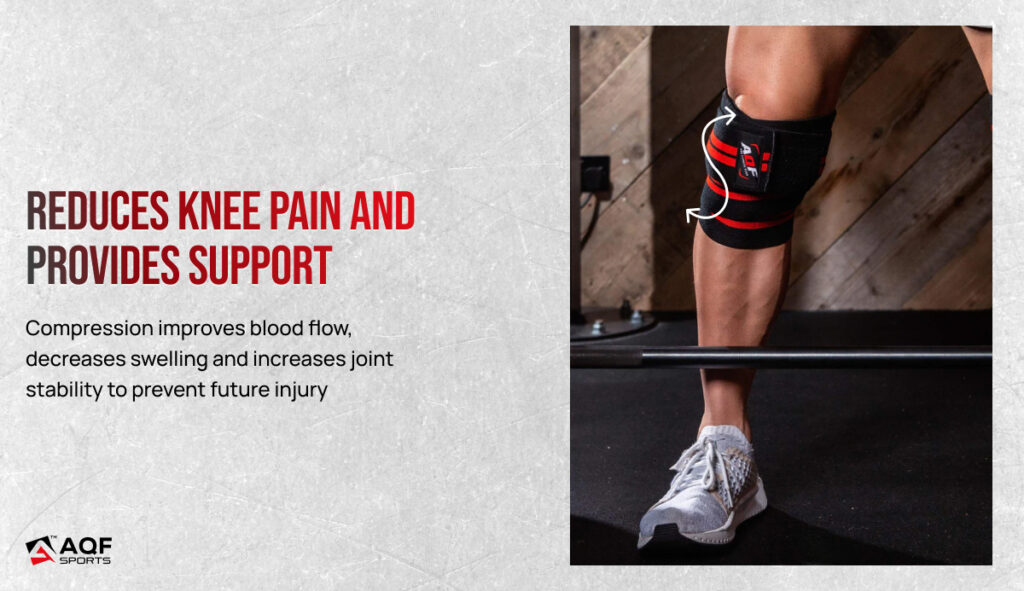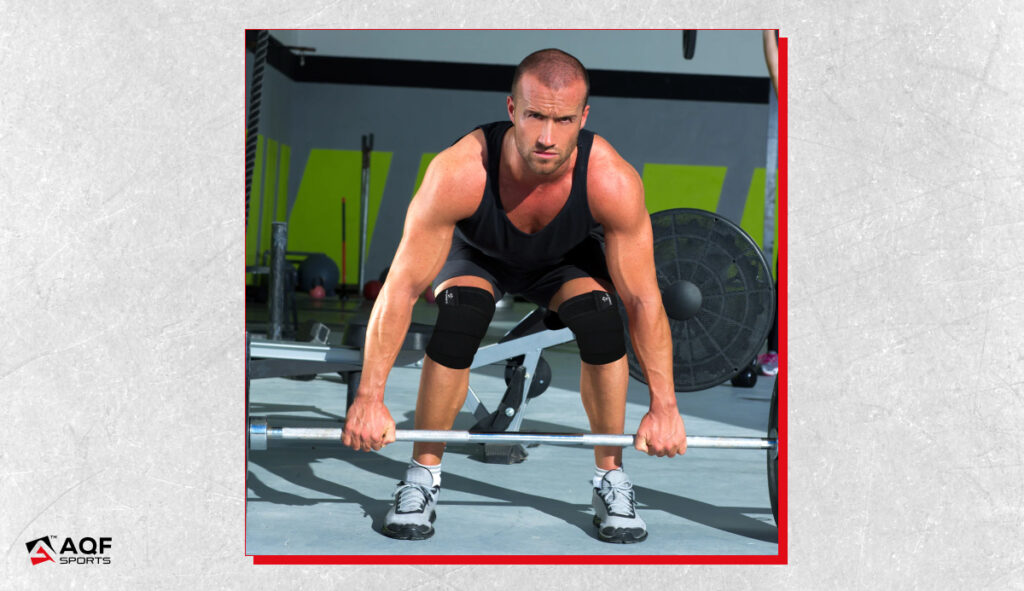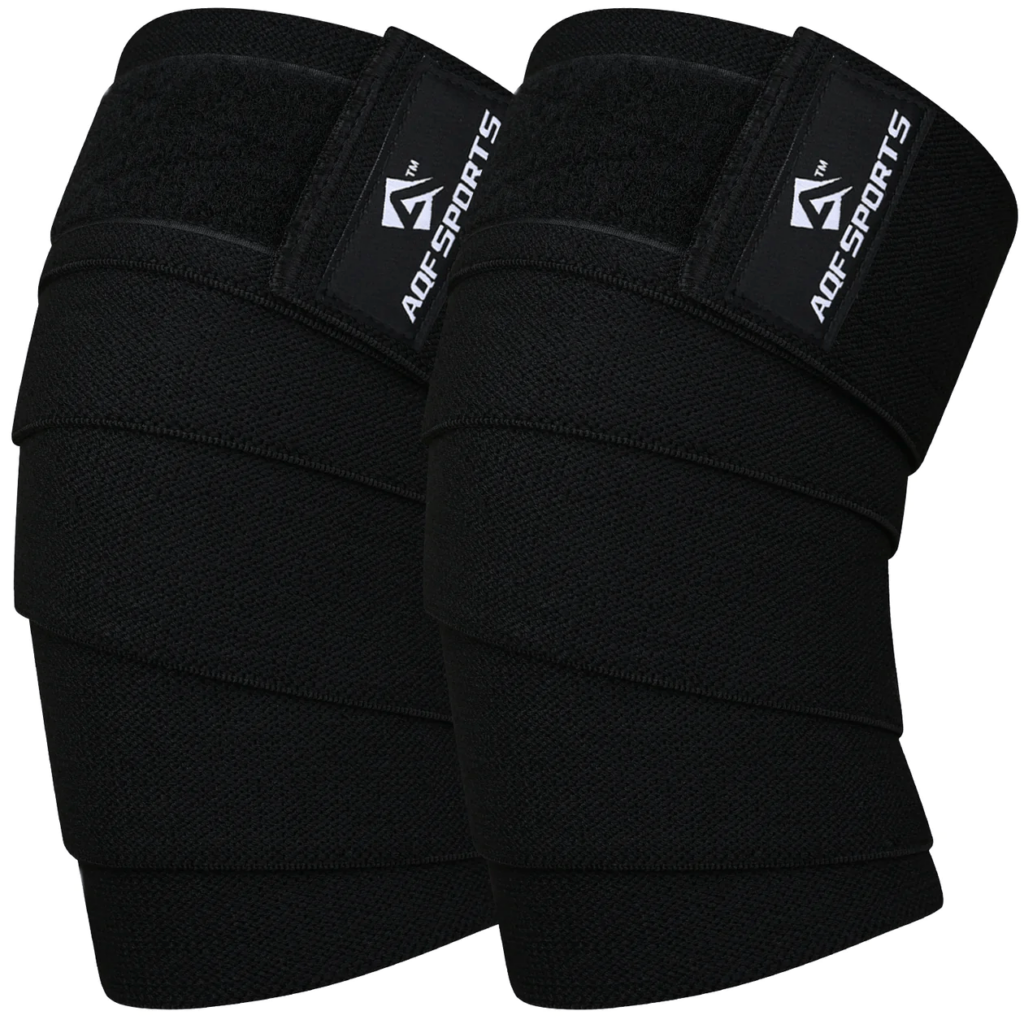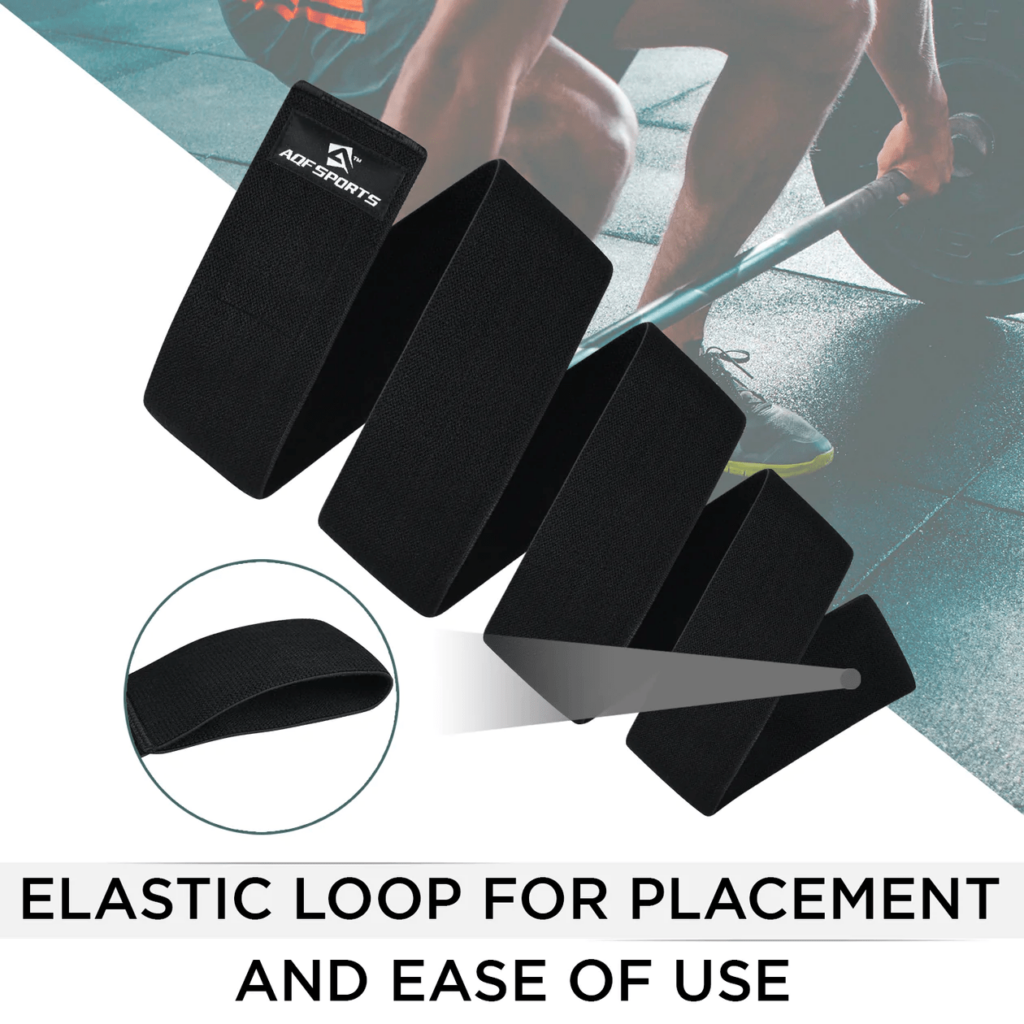How to Wear Knee Wraps for Powerlifting?

Knee wraps are supportive bands primarily used by athletes, especially powerlifters and weightlifters, during training or competitions. They are elongated strips of fabric designed to provide compression and support to the knee joint.
Knee Wraps for Powerlifting – Key Takeaways
- Knee wraps provide external support to the knee joint, enhancing stability during heavy lifts like squats and leg presses.
- They offer compression, aiding in energy storage and providing a boost during the upward phase of lifts, potentially enhancing performance.
- Properly applied knee wraps can help reduce stress on the knee joint and surrounding tendons, potentially lowering the risk of injury.
- Powerlifters, weightlifters, or olympicians use knee wraps for heavier sets (80%+ of 1RM) or to avoid temporary knee discomfort.
- Wrap them tightly from behind the knee joint for support but avoid excessive tightness that could impede blood flow or restrict movement.
- Look for wraps with appropriate length, width, material, and closure type to ensure proper support, flexibility, and durability.
Buy heavy duty knee wraps here.
Knee wraps are typically made of elastic materials like cotton, polyester, or a blend of both. These materials offer stretchability, allowing the wraps to be tightly wound around the knee.
Knee Wraps Provide:
- Compression:
Knee wraps compress the knee joint. This compression is essential for stabilizing the knee during heavy lifts, such as squats or leg presses. The wraps are wound tightly to create a ‘spring-like’ effect, storing potential energy during the lowering phase of the lift.

- Energy Storage:
As a lifter descends into a squat, the knee wraps store energy due to their elasticity. This stored energy assists in the lifting phase, aiding the lifter in pushing out of the bottom position, effectively providing a boost to the upward movement.
- Support:
Knee wraps offer external support to the knee, enhancing the joint’s stability. They reduce stress on the knee joint during high-intensity movements, minimizing the risk of injury by providing an additional layer of support to the tendons and ligaments surrounding the knee.

Proper Way to Wear Knee Wraps
Step 1: Prepare the Wraps
Roll the wraps tightly. This makes them easier to handle and ensures a tight, effective application.
Step 2: Start Wrapping
Wrapping starts behind the knee, circling below and above the patella (kneecap), providing essential support to the joint. The wraps are wound in a specific pattern, either in a straight line or a crossover fashion, depending on the desired support and comfort level.
Step 3: Tighten and Secure
The wraps are pulled snugly around the knee, striking a balance between providing ample support and not restricting blood flow or movement excessively.
Most knee wraps come with velcro fasteners or end pieces that are tucked securely to keep the wraps in place during lifts.

Step 4: Choose Your Style
There are two primary wrapping styles: the simple straight wrap and the basic crossover wrap.
- Simple Straight Wrap: Easiest to apply but less comfortable during squatting. Follows the middle stripe of the wrap.
- Basic Crossover Wrap: Slightly more complex, resembling a figure 8. Offers better patella alignment and increased support during squats.
Pro Tips:
- Use the wrap’s middle stripe as a guide for alignment.
- Cross the wrap in a figure 8 pattern for better support and patella alignment.
- Ensure the wraps are snug but not overly tight to avoid discomfort or restriction of movement.
Who Should Wear Knee Wraps for Powerlifting:
1. Powerlifters:
Powerlifters Benefit the most due to the need for strength and explosiveness in the sport.
Knee wraps offer stability, energy storage, and support during heavy lifts, aiding in achieving higher weights.
Suggested Read: Powerlifting vs Weightlifting Belt: Which One Is For You?
2. Strongmen:
Strongmen and athletes use knee wraps for short, intense activities to benefit from knee compression and support.
For longer events, removing knee wraps may prevent discomfort or restricted circulation.
3. Olympic Weightlifters:
Olympic weightlifters use knee wraps for additional joint support during heavy lifts.
Knee wraps increase range of motion and stability during snatches or cleans.
Suggested Read: Dips with Weight Belt [Complete Guide]
Who Might Not Need Knee Wraps for Powerlifting:
1. Beginners:
- Individuals who are still mastering foundational lifts like the barbell back squat.
- Building core strength and technique should be prioritized before introducing knee wraps.
2. Amateur Bodybuilders:
- Those whose primary focus is high-rep training to induce muscle hypertrophy.
- Rarely lifting near-maximal loads might not necessitate the use of knee wraps.
3. Recreational CrossFitters:
- Those who engage in circuit-style training with frequent transitions between exercises.
- High-rep sets and varied activities may not require the added support of knee wraps.
When to Wear Knee Wraps for Powerlifting:
1. Heavier Sets:
Reserve knee wraps for your heavier sets, typically at or above 80% of your one-rep max.
The added compression and support are most beneficial when handling substantial weights during squats or leg presses. More info here.
2. Addressing Discomfort or Pain:
Consider using knee wraps if experiencing temporary or moderate knee discomfort.
Wraps can help alleviate minor pain, allowing you to continue with planned training while ensuring you’re mindful of the underlying issue.
3. During Maximum Effort:
Opt for knee wraps when aiming for maximal effort or attempting personal bests.
The added stability and support can boost confidence under heavier loads.
When Not to Wear Knee Wraps:
1. Warm-Up Sets:
Avoid using knee wraps during warm-up sets with lighter weights.
The added compression might restrict blood flow unnecessarily during these lighter loads.
2. Everyday Training:
For individuals not experiencing discomfort or handling heavier weights, knee wraps may not be necessary for routine training sessions.
Reserve their use for moments requiring additional support or during heavier lifts.
Benefits of Knee Wraps for Powerlifting
1. Enhanced Performance:
Knee wraps provide compression, stabilizing knee joints during heavy lifts, aiding powerlifters in achieving higher weights and performing more reps.
2. Increased Strength:
The compression provided by knee wraps stores potential energy during the lowering phase of squats. This energy can be released during the lifting phase, assisting powerlifters in lifting heavier weights.
A study (“Wearing knee wraps affects mechanical output and performance characteristics of back squat exercise” 2012) highlighted that knee wraps increase mechanical output during back squats.
3. Joint Support:
Knee wraps offer external support to the knee joint, reducing stress and providing stability, especially during the eccentric (lowering) phase of squats.
4. Pain Relief:
Compression from knee wraps may alleviate minor knee discomfort or soreness during and after lifting sessions, allowing powerlifters to continue training without hindrance.
5. Confidence and Stability:
The added stability provided by knee wraps gives powerlifters more confidence in handling heavier weights, encouraging better performance during maximal efforts.
Things to Consider When Buying Knee Wraps
When purchasing knee wraps, consider the following factors to ensure you get the right pair:
1. Length:
Look for knee wraps that suit your preference in length. Most wraps range from 72” to 82”. Longer wraps allow for more rotations around the knee, providing increased support.
2. Width:
Opt for wraps that are at least 3” wide. Wider wraps cover a larger area around the knee, offering better overall support and compression.

3. Thickness:
Choose wraps that are around 0.2” (5mm) thick. This thickness ensures adequate support and compression without being overly bulky.
4. Material:
Select knee wraps made of elastic materials like cotton, polyester, or a blend of both. Elasticity is crucial for proper stretch and tension during wrapping.
5. Stretch and Flexibility:
Check for wraps with a good stretch. The material should allow for proper tightening without restricting blood flow or movement excessively.
6. Closure Type:
Consider wraps with velcro straps for secure fastening. Velcro closures make it easier to adjust the tightness and ensure the wraps stay in place during lifts.

7. Durability and Stitching:
Look for knee wraps with reinforced stitching. Strong stitching enhances durability and reduces the risk of fraying, ensuring longevity even with frequent use.

8. Warranty or Guarantee:
Consider brands or models that offer a warranty or guarantee. This provides assurance against potential defects and ensures the wraps can be replaced if necessary.
Prioritize comfort alongside support. Tightness is essential, but excessive tightness can lead to discomfort and restrict movement.
Consider trying different brands or styles to find the wraps that suit your specific needs and preferences.
The Bottomline
Knee wraps offer support and stability for powerlifters, weightlifters, and athletes handling heavier loads. They provide compression, potentially enhancing performance and reducing stress on the knee joint, aiding injury prevention. Use knee wraps strategically for heavier sets or temporary knee discomfort, but avoid excessive reliance in every workout. They benefit those seeking added joint support and should be worn during heavier lifts (80%+ of 1RM) or instances of knee discomfort, contributing to improved performance and injury prevention.
Discover More Topics






